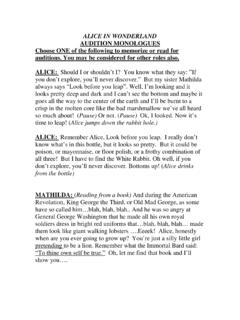Transcription of Clinical Mathematics for Anesthetists
1 Dosch Clinical Mathematics 2021 1 Clinical Mathematics for Anesthetists Michael P. Dosch CRNA PhD Professor, Nurse Anesthesia, University of Detroit Mercy ( ) Revised Aug. 31, 2021 I only took the regular and Writhing, of course, to begin with,' the Mock Turtle replied; 'and then the different branches of Arithmetic Ambition, Distraction, Uglification, and Derision. Alice's Adventures in wonderland , by Lewis Carroll Objectives Please keep in mind that all dosages in this document are for learning Mathematics only. Please check with your colleagues or reliable published sources to determine appropriate dosage for your patients. The purpose of this document is to collect mathematical tools useful in anesthesia practice, and increase patient safety by helping providers avoid drug errors.
2 While the five rights of drug administration1 and attention to systems that promote errors are fundamental, they are not mentioned here. 1. Convert fractions to ratio or decimal, decimals to percent, ratios to mg/mL or mcg/mL, percent solutions to mg or mcg/mL. 2. Know common SI (metric system) prefixes and be able to convert quantities between them. 3. Perform temperature conversions between Fahrenheit, Celsius, and Kelvin scales. 1 Dosch Clinical Mathematics 2021 2 4. Calculate desired rate setting for IV infusion pumps, given weight, drug concentration, and desired dose. 5. Convert weights in pounds to kilograms, and calculate mean arterial pressure.
3 6. Calculate FIO2 when air is being used rather than N2O. 7. Calculate ideal body weight when given actual weight and height in any units. 8. Calculate how long an E tank of oxygen will last at a given liter flow. Math Tools Review Further Reading Kee JL, Marshall SM. Clinical Calculations. 7th ed. 2013 (or newer editions). Drug Calculations for Health professionals- Quiz page2 Shubert D, Leyba J. Chemistry and physics for nurse anesthesia. 2nd ed. 2013 Cruikshank S. Mathematics & Statistics in Anaesthesia. Oxford Univ Press 1998 Basic Approaches Four basic techniques for solving many math problems are: Dimensional analysis, proportions, desired & available, and Lester s Rule for IV infusions.
4 Dimensional analysis To convert units, multiply by an identity (these are sometimes called conversion factors and are shown in parentheses in the formulae below). Examples: 760mmHg ( )= ( ) ( )=1013mBar ( ) 454gm ( )=1lb ( ) 50microgmmL (1mg1000microgm)= ( ) In each example, the fraction is an identity. For example, in formula , multiplying by an identity ( lb = 1,000 gm) changes 454 gm into the equivalent weight in pounds. Multiplying any quantity by an identity doesn't change the underlying quantity, only the units it is expressed in. 2 Dosch Clinical Mathematics 2021 3 Proportions Proportions are used to determine the answers to questions like "How far can I go on a half tank of gas, if a full tank will let me drive 300 miles?
5 " or, more pertinently, "How many mL of bupivacaine do I need to draw up to give the patient 12 mg?" To solve this question, you calculate that bupivacaine contains mg/mL (see "Percentage solutions" below on this page), then set up and solve a proportion: mL12mg ( ) (12mg) mL12mg (12mg) ( ) ( ) And mL=x Diluting drugs: Desired & Available The name desired and available is meant to indicate that you work from what you have available, diluting it to what you desire or need ( a more useful concentration). Some thoughts before beginning. Many medications: require dilution or reconstitution: phenylephrine, ephedrine, epinephrine, ketamine, vecuronium, remifentanil, and others.
6 Come in different concentrations- from one site to the next, sometimes even from one day to the next, as shortages dictate changes in supplier. It is imperative to read the concentration on the vial! Examples: ketamine (10, 50, or 100 mg/mL), epinephrine (1:1,000, 1:10,000, and 1:100,000), neostigmine ( or 1 mg/mL), etc. Example 1: Ephedrine. You have ephedrine 50 mg in 1 mL. You want to prepare a syringe with 10 mg/mL. What size syringe should you use? In the second step, you set up a proportion to answer the question, If the final concentration is to be 10 mg/mL, how much diluent do you add to 1 mL of ephedrine (50 mg/mL)? Available Ephedrine 50 mg in 1 mL vial Desired 1 mL10 mg =x mL50 mg ( ) 50 mg 1 mL10 mg =x mL50 mg 50 mg ( ) Dosch Clinical Mathematics 2021 4 Solving step gives 5 mL total volume.
7 So, take the 1 mL Ephedrine from the vial and add 4 mL sterile diluent in a 5 mL syringe. Example 2: Remifentanil. If you want to create a remifentanil infusion at the recommended adult dilution of 50 mcg/mL, and it is supplied as a vial containing 1 mg powder3, how many mL of diluent should you add to the vial? The first proportion (step ) cannot be solved as it is, since the denominator is in milligrams (on the left) and micrograms (on the right). So, in step , we multiply the right side by an identity ( conversion factor) which changes the denominator on the right side of the equation to mg, like the left. x mL1mg=1mL50mcg ( ) x mL1mg=1mL50mcg (1000mcg1mg) ( ) x mL1mg=1000mL50mg ( ) (1mg) x mL1mg=1000mL50mg (1mg) ( ) And thus, x = 20 mL.
8 Take the 1 milligram of remifentanil and add 20 mL diluent, which will result in a final concentration of 50 mcg/mL. Example 3: Ketamine You have ketamine 500 mg in 5 mL. You want to prepare a 10 mL syringe with 10 mg/mL. In the first step, you figure out where you are going (by finding the total drug mass that needs to be in that syringe). In the second step, you determine what volume you need to withdraw from the vial to get the total drug mass you want in the syringe. Desired = ( ) ( ) Available 500 mg5 mL = 100 mgX mL ( ) 3 Remifentanil is supplied as a powder, in vials containing 1, 2, or 5 mg.
9 #dosage Dosch Clinical Mathematics 2021 5 Solving gives 100 mg per 1 mL. Therefore take ketamine 1 mL from the vial (which gives the 100 mg total drug you want in your 10 mL syringe) and add 9 mL of diluent. Label it properly, of course, as containing 10 mg/mL ketamine. Example 4: Epinephrine is available, marked "1/1,000" and "1 mg/mL." You are asked to "double-dilute" it, so you take 1 mL of the epinephrine 1:1,000, and add 9 mL diluent. Then you discard all but one mL of the new mixture, and add 9 mL diluent. What is the resulting concentration of epinephrine in micrograms/mL? Epi 1:1,000 contains 1 mg/mL (= 1,000 mcg/mL). Taking 1 mL and adding 9 mL diluent yields a syringe with 1,000 mcg/10 mL (100 mcg/1 mL).
10 Taking 1 mL of this mixture (containing 100 mcg/mL) and adding 9 mL diluent to it yields a syringe containing 100 mcg/10 mL. Each mL of the double-diluted new mixture contains 10 mcg/mL. Example 5: Epidural syringe preparation. Available: bupivacaine ( mg/mL), fentanyl 50 mcg/mL, and sterile diluent. Desired: A 60 mL syringe, containing (this is often called 1/16 %) bupivacaine with fentanyl 5 Here s Method 1: First, what is the total drug mass that you will end up with in the 60 mL syringe? Bupivacaine: contains mg/mL. o How do we know this? A percent solution means grams per 100 mL. So % means grams of drug in 100 mL of solution (and mg/mL).





